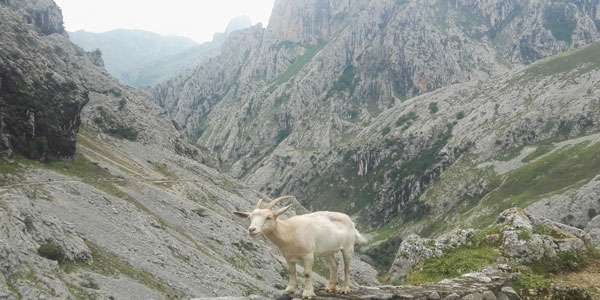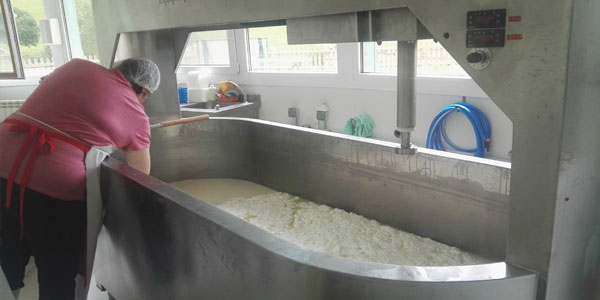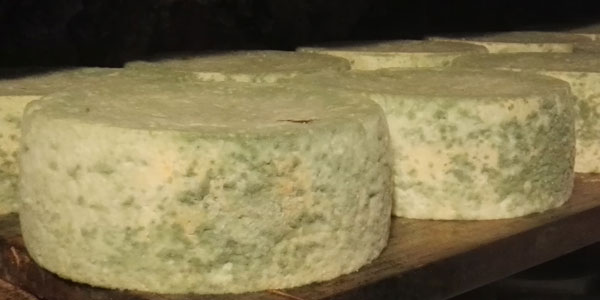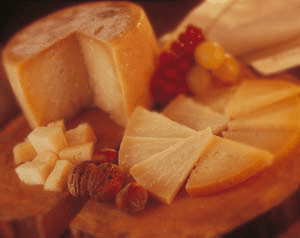Write: Monica Uriel. Journalist
The Picos de Europa allow you to visit some of the natural caves where Cabrales cheeses mature. In addition to traveling the famous Cares route or going up to the lakes of Covadonga and Bulnes. Cheeses acquire the penicillium fungus, which is what gives them their special characteristics.
Cabrales cheese, unique
The Cabrales is one of the few cheeses in the world, along with the Asturian Gamonéu, which matures in caves. This is where the cheesemaker performs the most important work in the process.
They are caves that are full of history, since the shelves on which the cheeses rest are inherited from generation to generation. In the Council of Cabrales there are about twenty caves, some only accessible on foot.
Picos de Europa

Bulnes and Poncebos
We visit one of them in Sotres, one of the three Asturian towns that are within the Picos de Europa National Park. Together with Bulnes and Tielve. To Bulnes you can make an excursion from Poncebos through a gorge. This was the only way to get there until a funicular was inaugurated in 2.000.
For its part, Poncebos is also one of the starting points of one of the best known trails in these mountains. It is the Cares route, 11 kilometers long, cut into the rock. It runs through the so-called “Divine Throat” of the Cares River to Caín, through a spectacular gorge.
Sotres, with a hundred inhabitants and an altitude of 1.050 meters, is the highest Asturian town. The Maín cheese factory (www.quesosdecabrales.es), owned by Javier Díaz. This follows the family tradition of more than one hundred years started by his great-grandmother. She traded the cheese for other products.
The cheese factory has a cave, both of which can be visited. You can find it along with others in the App and web www.catatur.com. They are located on the outskirts of Sotres.

The cave is one of the smallest in the council and it holds 950 cheeses. The regulatory council is the one that grants the authorization to the cheese makers to use the caves. They can be for individual or collective use. Javier inherited it from a relative who stopped making cheese 8 years ago.
Cabrales cheese maturation process
"The most important job of the cheesemaker is that of the caves, where the cheeses in a week already have the penicillium fungus," he explains. “Once a week you have to come here to clean it. The water that is filtered from the caves is used and the cheese is submerged until it is free of mold, brushed and turned over ”, he continues.
This work is done once a week throughout the four months that the cheeses remain here. The law establishes a minimum maturity of two months for carrying raw milk.
The cave always has 95% humidity and is less than 10ºC. It is precisely the high humidity and low temperature that favor the appearance of the fungus. It is this that gives Cabrales its greenish-blue streaks.
Two more caves with peculiar accesses
The Maín cheese factory has two other ripening caves. In one, the horses are the ones who must carry the cheeses part of the way. Meanwhile, in the other, located 1.500 meters above sea level, only the cheese maker can access. This one carries in backpacks up to six cheeses in each one. Walk upstairs for an hour and a half.
In these two caves the temperature is lower and the maturation is slower, 10 months. The longer the Cabrales mature, the softer the cheese paste will be. In turn, depending on the material of the cave (mud or limestone) it provides different nuances.
For Cabrales, cow's milk is mainly used, although it can be a mixture of goat, sheep and cow. Many years ago these cheeses were more of goat and sheep than of cow. However, goat and sheep milk are more expensive and more difficult to obtain.
Sheep and cows
Goat and sheep farming has declined due to the increasing presence of wolves in the Picos de Europa. They increased and were protected by becoming a Natural Park. Javier has 54 goats, which together with those of another rancher are the only ones that are now in Picos.
20 years ago, there were many more: 3.500 goats and sheep. Javier buys cow's milk from a farmer and in winter and spring they mix both milks. Meanwhile, the rest of the year he makes cheese only with cow's milk.

In the process of making Cabrales, once the whey is removed, kneaded and placed in molds, the cheese is not pressed because the holes would close and there would be no mold. The cheeses stay in the molds for two days and little by little the pasta goes down by gravity and the holes remain inside. After adding salt, they remain in the drying room for up to 20 days before being transferred to the caves.
Vega de Tordín, another cheese factory
In another of the Cabrales cheese factories, Vega de Tordín, in Arenas de Cabrales, you can attend the milking of cows by a robot. Between two and six times a day the milking robot, of Dutch patent, milks between 30 and 40 cows, from which three types of milk come out (healthy, unhealthy and colostrum). The cows carry a chip that allows us to know the milk they have given, its weight and, according to this, they are given more or less feed.
The young cheese from Vega de Tordín, with a maturation of between 2 and 5 months - they have a select one between 5 and 7 months, and a reserve one between 7 and 9 months - won the first prize of the Cabrales Cheese Contest in 2016 and a restaurant in Madrid paid 11.000 euros to take it away in a bid in which until then the maximum that had been paid was 3.000 euros.
In Arenas de Cabrales you can also learn about the process of making honey with El Meleru (https://about.me/elmeleru), which organizes 4-hour routes between centenary chestnut trees and allows visitors to be a beekeeper for a day in an apiary.
Cangas de Onis
30 kilometers from Arenas de Cabrales is Cangas de Onís, in whose market you can find all kinds of Cabrales cheeses. And from here you can access another essential visit to Picos, the Lakes of Covadonga and its sanctuary.
At the foot of the basilica and with views of it in the Covadonga picnic area, you can eat the cachopo -popular Asturian dish based on beef fillet- which was a finalist in the contest of the past Gourmet Hall.







